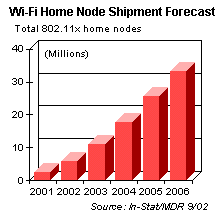Wi-Fi wireless poised to take off
Oct 29, 2002 — by LinuxDevices Staff — from the LinuxDevices Archive — viewsScottsdale, AZ — (press release excerpt) — As the wireless home networking space evolves to one which involves the wireless connection of the PC cluster of devices (broadband modem, router/AP device, desktops, laptops, PDAs, web tablets) to the entertainment cluster of devices (audio and visual equipment such as TVs, DVD players, MP3 players, gaming devices and home theater devices such as high-end… displays and DVRs), Wi-Fi technology will take the lead.
 High tech-market research firm In-Stat/MDR projects that with 802.11b already being accepted into the home and 802.11a already beginning to penetrate early adopter homes, worldwide annual Wi-Fi node shipments will be 33 million in 2006, up from the approximately 6 million nodes expected to ship out in 2002.
High tech-market research firm In-Stat/MDR projects that with 802.11b already being accepted into the home and 802.11a already beginning to penetrate early adopter homes, worldwide annual Wi-Fi node shipments will be 33 million in 2006, up from the approximately 6 million nodes expected to ship out in 2002.
“With Wi-Fi AP gateway devices available for about $120, and with PC cards falling to the $50-70 range at retail and e-tail, as of 2H 2002, end-users are readily accepting Wi-Fi as an attractive method of wirelessly sharing broadband Internet access,” says Gemma Paulo, a Senior Analyst with In-Stat/MDR. “The popularity of Wi-Fi in the home has generated increased interest in extending this wireless home network to entertainment and home automation clusters, opening the door to Wireless Personal Area Network (WPAN) technologies such as Ultra-wideband (UWB) and Zigbee.”
In-Stat/MDR has also found that:
- Low-end networking hardware specialists such as Linksys, Buffalo, Netgear, D-Link, SMC, SOHOware and Actiontec have driven the success of Wi-Fi in the home, as they have driven costs down, increased the variety of Wi-Fi products on the market, and have focused on making set-up and installation easier.
- Although the United States is expected to remain the largest market for wireless LAN equipment in the home and SOHO space through 2006, Asia Pacific is quite notable for its growth. Japan, S Korea, Taiwan, Hong Kong, Australia and Singapore all present good areas of growth for Wi-Fi.
- Although Wi-Fi is expected to be embedded in consumer electronics devices going forward, its lack of multimedia support and bandwidth limitations have opened the door to UWB as a potential contender in the video distribution arena. Quality of Service (QoS) enhancements are expected to be added to the 802.11 standard by next year; however, UWB does offer much higher throughputs, albeit at much shorter ranges.
- Other promising wireless technologies for the home include Zigbee, designed for home automation of lighting and security, as well as Spike, a technology designed initially for video game controllers. Mesh peer-to-peer technology may also show up in the home of the future, possibly to extend the range of WLAN or WPAN technologies.
The report, Wireless Cribs: Living Large with a Wireless Home Network (#IN020234RC), contains detailed Wi-Fi forecasts, by technology (2.4 GHz, 5GHz, dual-mode 2.4/5GHz), by form factor (NIC, AP), and by geography in addition to UWB node and Zigbee forecasts. Analysis of the Wi-Fi IC market players and an analysis of Wi-Fi embedded vs non-embedded clients going forward, are also provided.
This article was originally published on LinuxDevices.com and has been donated to the open source community by QuinStreet Inc. Please visit LinuxToday.com for up-to-date news and articles about Linux and open source.